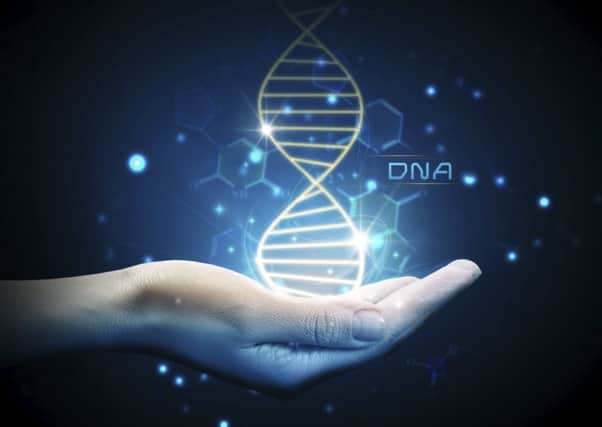Alistair Moffat: Scots link to first Adam


As one of the oldest schools in continuous existence in Scotland, Inverness Royal Academy is used to being part of history and when work began on a larger site to the south of the city in late 1975, a new era began. And an ancient era was accidentally revealed. Workmen levelling the ground near Culduthel Mains Farm skinned the lid off a stone cist and a pale winter light shone on a skeleton at least 4,000 years after it had been buried. As well as teaching history, Inverness Royal Academy was inadvertently making it. The cist-grave revealed a fascinating, epoch-changing period of Scotland’s history, one that was significantly better understood because of new data produced by ScotlandsDNA.
Around the skeleton a group of objects, grave goods, were arranged and each had a tale to tell of our prehistory. Largest was a finely made bell-shaped pot known as a beaker. Thin-walled, beautifully turned and with its characteristic decoration added by pressing twisted cords into the clay while it was wet, the beaker was of a type first made in Portugal around the estuary of the wide River Tagus some time around 2,800BC. It seems that Inverness was a northern destination for a long cultural migration from the southernmost ends of Europe.
Advertisement
Hide AdAdvertisement
Hide AdWhat became known as the beaker package spread very quickly across Western Europe, far too quickly to be understood as a process of gradual adoption. The movement of the ability to make these fine pots and use them at the funerals of important people must have involved the movement of people over long distances. Ancestral DNA evidence adds important support. At a beaker cemetery at Kromsdorf in Germany, ancient DNA was extracted from two male skeletons and it turned out to be R1b, a Y chromosome super-cluster that is found in very high frequencies in Northern and Western Europe. In Scotland, our research has detected an overwhelming majority, a staggering 70 per cent of all Scotsmen carrying it. The crucial question is – why? What made the R1b men so successful that they outbred other lineages and became the ancestors of almost threequarters of all Scottish men? Important parts of an answer lay in the cist opened in Inverness in 1975 on a cold November day.
Next to the beaker, archaeologists found eight expertly knapped and very sharp flint arrowheads, their wooden shafts having long since perished. And beside them was a bracer. Made from stone and set with four gold rivets, this was attached to the arm of an archer that held the bow and it prevented painful whiplash from the bowstring. Other beaker burials in Aberdeenshire and near Stonehenge also contained archery kit, and importantly, more substantial evidence of the coming of metalworking. There were copper daggers of great keenness and gold jewellery. A new people with dazzling new skills had arrived in Britain, an invasion clearly seen in the genetic as well as the archaeological record.
At ScotlandsDNA we have compiled the Great Tree of Mankind, a family tree of all men on Earth showing their descent from a single individual, the man known as Y chromosome Adam. He lived about 215,000 years ago. On a huge layout, we have shown how 573 Y chromosome sub-types descend from Adam. These include many newly discovered sub-types in Scotland. Uniquely, it also shows a hugely important historical turning point, what we believe is the enormous and immediate impact of the coming of the Beaker People.
The branches of the Tree immediately below Adam divide only very slowly over a long period of time. This is because he and his descendants were hunter-gatherers who probably lived in family bands and patrolled their ranges to find a wild harvest of roots, fruits, fungi and animals they could trap or bring down. Populations grew slowly.
But then the Great Tree abruptly changes. About 4,500 years ago, many new branches suddenly appear over a very short period. This is noticeable across the whole Tree but particularly clear under the very Scottish haplogroup, R1b S145, where a staggering 25 new branches are found. Only in Ireland is the percentage of men in this haplogroup higher than in Scotland. What this means is something simple yet very significant – many more children are being born and surviving to adulthood. The men born at this time created new sub-types in the Y chromosome Tree which then created more in a huge lateral expansion.
This happened because of the greatest revolution in our history, the coming of farming and the increasing sophistication of its techniques. It had come to Britain before c2,500BC but new peoples clearly changed its practice in some way around that time. It may be that the Beaker People better understood how to grow grain. The earlier farmers carried different genetic lineages, in particular the G haplogroups. Establishing farmland involved immense effort such as woodland clearance and the notion of ownership of land grew stronger. When the Beaker men arrived, almost certainly expert in archery, with sharp metal weapons and probably horse-riding skills, they began to take over and not only displace the earlier pioneers but probably also killed them. Or if they were displaced, they moved to poor land and did not thrive. The relatively low incidence of other Y chromosome lineages in Scotland compared to R1b certainly suggests radical population shift, violent or otherwise.
It is a hypothesis, but a very plausible one, that the cist at Culduthel is more than a simple grave, but rather, a memorial to a prehistoric takeover, perhaps even a genocide as the ancestors of 70 per cent of Scotsmen seized land and began to multiply.
• For more information, e-mail [email protected] or call 0345 4502483.
Advertisement
Hide AdAdvertisement
Hide Ad• To read the full extended version of this article, go to www.scotsman.com/lifestyle/heritage
• Next Friday: Part 3 – Bringing alive the lost kingdoms of Scotland